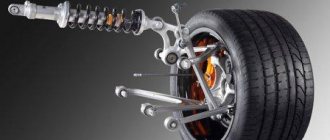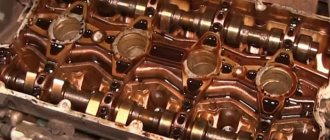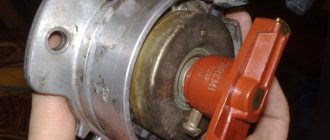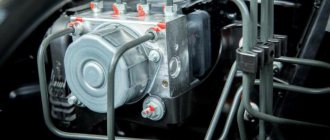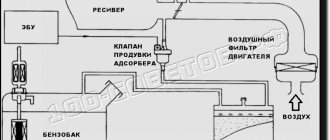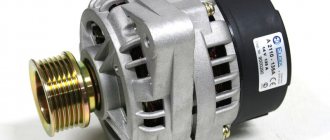The flywheel is part of the crank mechanism, clutch system and engine starting system, in the form of a large mass disk with a ring gear. Some modifications of flywheels have their own abbreviations - read about them in the “types of flywheels” section.
photo gallery:
Who is he and where is the flywheel located?
The classic flywheel itself is quite simple - it is a massive metal disk with a diameter of about 30-40 centimeters. It is usually made from cast iron.
Along the outer circumference of this circle is a steel rim with teeth, called the flywheel crown. Gears play a very important role in this unit, but we will talk about this a little later.
Where is the flywheel located? You won't be able to find the flywheel under the hood of a car at first glance. This part is located deep in the engine and is protected from prying eyes by casings.
More precisely, the place of this metal disk is at one of the ends of the crankshaft, which, as you already know, is spun by the engine pistons.
The flywheel is attached to the crankshaft very firmly, since it has to withstand extreme loads and act as an intermediary between the engine and the gearbox.
We have already talked about what the flywheel looks like and where its place in the car is, now we need to find out the most important thing - whether it is really needed. Despite the external simplicity and the absence of complex shapes, without this part the car will not start moving, and indeed will not start at all. The flywheel performs the following functions:
- damping of parasitic crankshaft vibrations;
- transmission of engine torque to the transmission;
- ensuring connection between the starter and the crankshaft.
Let's take a closer look at the above points. One of the key roles of the flywheel is to guarantee smooth operation of the engine and dampen various types of mechanical vibrations and vibrations.
It is for this purpose that the disk is made of heavy cast iron - the main thing here is its mass, which ensures the accumulation of energy and maintenance of the crankshaft torque using inertia.
The next role is no less important - the flywheel acts as an intermediary between the engine and the gearbox, and is also, in fact, part of the clutch mechanism. All the engine power and torque, which car enthusiasts love to brag about, passes through this modest but heavy disk and rushes further through the transmission to the wheels.
And finally, the last function of the flywheel. A little earlier, when describing the structure of this part, we mentioned the teeth located along the outer circumference of the disk, the so-called crown.
With their help, the moment you turn the key in the ignition switch, the starter gear engages with the above-mentioned teeth, which creates primary rotation of the crankshaft and starts the process of fuel combustion in the cylinders. In other words, the engine starts working.
Possible faults
Below are the most common part malfunctions.
- Wear of the crown. Over time, the teeth on the ring can wear out, causing the starter to slip on them when starting the engine. Starting the car will be problematic - it will not work the first time.
- Misalignment. The flywheel must be installed coaxially with the cardan and clutch disc. Otherwise, when moving on a vehicle, the so-called “beating” will be heard.
- Disc wear. The part of the part that performs the functions of the clutch disc is subject to the most severe loads. As a result of this, it can wear out, and burrs and depressions may appear on its surface. The result of all this is a reduction in the size of the contact area of the transmission discs and, as a result, poor clutch. Another sign of a breakdown is noise when the car moves.
- Wear of crankshaft fasteners. The place where the crankshaft is attached also wears out over time. As a result, backlash appears. It causes noise while the vehicle is moving.
All of the above breakdowns occur in single-mass or lightweight devices. In dual-mass models, dampers may also malfunction. It is most often expressed in their wear. As a result, the part of the structure connected to the crankshaft does not transfer all the energy to the part that is the clutch disc. You can tell that problems have arisen by looking at the following “symptoms”:
- noise, knocking;
- the appearance of so-called floating revolutions;
- spontaneous “twitching” that occurs at idle;
- increased vibration level when driving;
- jerking when changing gears.
Kinds
Today there are three types of flywheels:
- Solid . It is a simple cast iron disk with teeth on the end. Such models are common on both domestic cars and foreign cars, especially economy class ones.
- Lightweight . As a rule, a lightweight version of the drive disc is installed either on cars with an automatic transmission or on tuned models. The main feature of such a disk is its reduced mass, as a result of which a decrease in inertia is achieved and an increase in engine efficiency of up to 5%. A lightweight flywheel is a structurally simplified version of the solid type. Its main purpose is to act as a gear that rotates when the starter starts.
- Dual mass or damper . Currently, it has become widespread due to its advantages - damping vibration, eliminating torsional vibrations of the crankshaft, increasing the wear resistance of synchronizers, protecting the transmission from overloads and reducing noise. A structurally more complicated flywheel model compared to previous types.
Selection and purchase of parts
Flywheels are selected by VIN code or car model/make or engine code . When choosing between original parts and analogues from the world's leading manufacturers, take into account the fact that manufacturers such as LUK and Sachs invented the dual-mass flywheel design and most often their parts are installed in cars from the factory. Therefore, if there is a difference in cost between the original and LUK/Sachs products, choose what is cheaper - the box will contain the same thing.
The single-mass flywheel is replaced only with a part of the same design . Lightweight flywheels are used for tuning cars, but it cannot be simply installed - you need to change either the engine components, or at least the settings of its operation.
The dual-mass flywheel should be replaced with a similar part . But some manufacturers propose replacing dual-mass flywheels with a more reliable single-mass flywheel design with certain modifications. Such conversion kits are offered by Valeo, another world's largest manufacturer of auto parts and dual-mass flywheels. Such a replacement is still a controversial issue - manufacturers such as LUK and Sachs claim that this cannot be done - no single-mass flywheel can cope with the tasks of a dual-mass flywheel (primarily vibrations and torsional vibrations), so you reduce the life of the gearbox and other related parts . Valeo, which offers such a replacement, claims that its engineers have thought of everything and such a replacement is allowed only for certain engine models (VAG 1.9, 1.8 turbo, Passat B5, Caddy, Audi A3, Audi TT, Golf5, Golf6, Skoda Octavia in the first body, almost all models of the VAG group from the 2000s to 2009 with 1.8 engines).
Related terms
- Crankshaft
- TDC - Top Dead Center
Features of the dual-mass flywheel design
The design features of the part consist in the presence of two housings, one of which is installed on the crankshaft with subsequent connection to the crankshaft, and the second is in contact with the working surface of the clutch disc. The connection between the housings is ensured by two bearings (axial and radial), which can slide freely regardless of each other’s operation. Also in the middle of the part there is a damping system consisting of springs. All mechanisms are treated with a special grease, which ensures reliable operation of the springs and separators between them
.The dual-mass flywheel contains two spring packages. A soft spring package ensures soft starting and stopping, while a hard spring package provides damping of vibrations in the operating speed ranges of the engine.
How to prevent flywheel wear
Despite the fact that the flywheel has a huge resource, improper handling of the car can significantly reduce its service life. Here's what not to do to preserve flywheel life:
- Driving at low speeds off-road greatly overloads the flywheel damping system.
- A sharp start from a standstill, even from low speeds.
- Frequent towing of very heavy trailers causes rapid wear on the flywheel and clutch.
- Release the clutch pedal.
- Don't slip.
- Frequent starting and stopping of the engine.
- Frequent gear changes.
- Do not start driving in high gears.
- Engine chip tuning.
- Drive aggressively.
Flywheel repair
Repairing the flywheel ring During rotation, the Bendix gear meshes with the teeth of the flywheel ring. Therefore, the entire load during operation is placed on the gears. Over time they wear off. As a result, the car breaks down, which is manifested by the following symptoms: the car does not start well, the starter clicks, but does not spin. These symptoms are not constant. The car starts up, then the starter clicks or crackles again. This indicates poor engagement of the Bendix gears and the flywheel. If the flywheel teeth are worn out in a certain place, the starter spins and does not start the engine until the flywheel rotates the defective place.
After some time, the gears engage and the engine starts. It is necessary to inspect the flywheel ring and bendix gear, and if worn, replace them. You can do the repair yourself. To do this, you need to remove the flywheel from the car and use a hammer and chisel to knock out the crown. If the new crown is not put on, it must be heated with a torch or, even better, an electric stove and, tapping with a hammer, pressed evenly onto the disc. Note! The crown must be heated over the entire surface and not very much. If you heat it up until red hot, this will contribute to rapid wear of the teeth in the heating areas. Sometimes, if the teeth are not very worn, the crown is removed from the flywheel and put on the other side. To do this, you need to mark the disk and the crown with several marks so that you can turn it over and put it in the same place. This will keep the flywheel as balanced as possible.
Usage[edit
Used in machines that have an uneven supply or use of energy, storing energy when the energy supply is higher than the consumption, and releasing it when the consumption exceeds the energy supply. Also used in hybrid engines as energy storage and for regenerative braking, gyrobuses.
Often the function of a flywheel is performed by a massive rotating element of the mechanism. Such as a potter's wheel, massive watermill wheels or massive gear wheels.
In addition to energy, a rotating flywheel (like any rotating body) also has angular momentum, which is associated with the observation of the gyroscopic effect, which consists in the precession of the rotation axis around its original direction when an external force appears that does not coincide with the direction of the rotation axis.
The first example of the use of the gyroscopic effect can be considered the invention of the spinning top (yo-yo).
One of the first applications of the gyroscopic effect was the transition in the 19th century from firing round cannonballs to oblong projectiles, the rotation of which made it possible to maintain their orientation in space, and the oblong shape significantly increased their mass (blank) or explosive charge with equal aerodynamic resistance.
The flywheel is also the rotor of the gyroscope, used in gyrocompasses and in general in gyroscopic devices for orientation in space, in particular torpedoes (Aubrey device), rockets and spacecraft. The most common examples of a flywheel are a bicycle wheel or the rotating disk of an electric vinyl record player.
